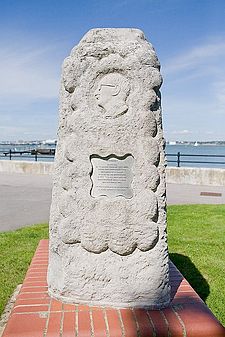- Christopher Cockerell
-
Christopher Cockerell 
Memorial to Sir Christopher Cockerell at HytheBorn 4 June 1910
Cambridge, United KingdomDied 1 June 1999 (aged 88)
Hythe, Hampshire, United KingdomResidence England, United Kingdom Citizenship British Fields Engineering Alma mater Peterhouse, Cambridge Known for The Hovercraft Notable awards Fellow of the Royal Society Sir Christopher Sydney Cockerell CBE FRS[1] (4 June 1910 – 1 June 1999) was an English engineer, inventor of the hovercraft.
Contents
Life
Cockerell was born in Cambridge, where his father, Sir Sydney Cockerell, was curator of the Fitzwilliam Museum, having previously been the secretary of William Morris. Christopher Cockerell was educated at Gresham's School, Holt.[2] He then entered Cambridge University as an undergraduate member of Peterhouse, and where he studied engineering and was tutored by William Dobson Womersley. He began his career working for the Marconi company in 1935, and got married soon afterwards. He worked on radar systems during the Second World War.[3]
Cockerell was awarded the Howard N. Potts Medal in 1965.
Cockerell was knighted in 1969 for his services to engineering. He died at Hythe in Hampshire.
The hovercraft
Cockerell's greatest invention, the hovercraft, grew out of work he began in 1953. He tested his theories using a hair-dryer and tin cans and found his working hypothesis to have potential, but the idea took some years to develop, and he was forced to sell personal possessions in order to finance his research. By 1955, he had built a working model from balsa wood and had taken out his first patent. Cockerell had found it impossible to interest the private sector in developing his idea, as both the aircraft and the boat-building industries saw it as lying outside their core business. He therefore approached the British Government with a view to interesting them in possible defence applications.
This led to Cockerell being introduced to the NRDC (National Research Development Corporation).[citation needed] In the autumn of 1958, the NRDC placed an order with Saunders-Roe for the first full-scale Hovercraft. This prototype craft was designated the SR-N1 (Saunders-Roe - Nautical One) and was manufactured by Saunders-Roe under licence from the NRDC. In 1959, he launched the SR-N1, which was capable of carrying four men at a speed of 28 miles per hour. It made a successful crossing of the English Channel between Dover and Calais on 25 July 1959.[4]
In January 1959, the NRDC formed a subsidiary called Hovercraft Development Ltd. Cockerell was the Technical Director and the company controlled the patents which it used to license several private-sector firms to manufacture craft under the registered trademark of Hovercraft.[citation needed]
The World's first Hovercraft service operated briefly across the River Dee estuary between Rhyl (North Wales) and Wallasey (now Merseyside in the Wirral Peninsula) for 36 days in 1962. The craft was designated the VA-3 and was manufactured by Vickers Armstrong Corp. The service was operated by British United Airways.
In later life Cockerell developed the Cockerell Raft, a wave power hydraulic device which may have implications in the future for electricity generation.
Sir Christopher Cockerell's theory was that instead of using the plenum chamber – an open-bottomed empty box such as Thornycroft had devised – if air could instead be pumped into a narrow tunnel around the perimeter of the underneath side of the craft, it would flow toward the center, creating a more effective air cushion. This peripheral jet would allow the air pressure to build enough to equal the weight of the craft and, since the air would be trapped, the pressure would elevate the craft off the surface upon which it traveled.
Cockerell tested his theory with a test model constructed of two empty cans, an industrial air blower and a pair of kitchen scales. By inserting a cat food can into a coffee can, and blowing air through the gap between the two cans, he showed that it was possible to increase the hoverheight and to construct a vehicle that could travel on a cushion of air.
Commemoration
A plaque in Cockerell Rise, East Cowes, Isle of Wight, marks the location of White Cottage, where Cockerell lived and worked. The Cottage has been demolished, but the garage still stands. Plaque erected by Friends of East Cowes with funding by the Big Lottery.
References
- ^ Wheeler, R. L. (2001). "Sir Christopher Sydney Cockerell, C.B.E., R.D.I. 4 June 1910 -- 1 June 1999: Elected F.R.S. 1986". Biographical Memoirs of Fellows of the Royal Society 47: 67. doi:10.1098/rsbm.2001.0005.
- ^ Lidell, Charles Lawrence Scruton & Douglas, A. B., The History and Register of Gresham's School, 1555-1954 (Ipswich, 1955)
- ^ Cockerell, Christopher, in Oxford Dictionary of National Biography (Oxford University Press, 2004)
- ^ Evans, Eric, British History (Bath, Parragon Books, 2002) p. 305
External links
- Information about Sir Christopher at the Hovercraft Museum website
- hovercraftsomerleyton.org.uk Detail of commemorative events at the birthplace of the Hovercraft including The Hovercraft Column at Somerleyton in Suffolk.
- Christopher Cockerell profile at findagrave.com
- Christopher Cockerell at About.com
- Christopher Cockerell in the Oxford Dictionary of National Biography
Categories:- 1910 births
- 1999 deaths
- English inventors
- English engineers
- People from Cambridge
- Old Greshamians
- Alumni of Peterhouse, Cambridge
- Fellows of the Royal Society
- Commanders of the Order of the British Empire
- Royal Medal winners
Wikimedia Foundation. 2010.
